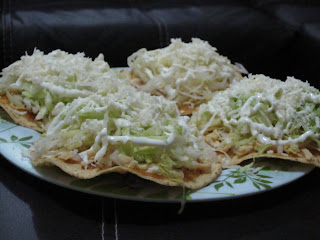
Fruit is fruit (is fruit, as Gertrude Stein might point out), but for me, fruit is not dessert, one of the few points on which Mexico and I disagree. Outside of the standard tres leches cake for special occasions, fruit dominates the table as post-dinner snack. It's not as if Mexico doesn't have the ingredients or the oh-so-American sweet tooth; it just seems that, with the ever present viable option of fruit, desserts simply don't happen. Instead of dessert, Maizena is used in a variety of medicinal home remedies and dulce de leche (or cajeta as we say in Mexico) is relegated to a slathering on a slice of Bimbo white bread for breakfast.
Well, fruit is not a viable option for me after dinner, and, luckily, Argentina and Peru (and possibly other countries throughout Latin America) have found a better use for dulce de leche and Maizena corn starch. Alfajores, a corn starch cookie sandwich with dulce de leche in between, combines some of the most popular items on a Mexican grocery list (Maizena, coconut and cajeta) to create a super tasty treat. (And while it's flavor profile should make it a popular snack here, it's difficult to find - probably because it's not fruit!)
Ingredients
200 g AP flour
300 g corn starch (Maizena)
1/2 tsp. baking soda
2 tsp. baking powder
1/2 tsp. salt
200 g butter, softened
150 g sugar
3 egg yolks
1 tsp. vanilla extract
1 tsp. lemon zest
dulce de leche, spreadable
shredded coconut, unsweetened
Directions
1 - Preheat the oven to 350*.
2 - Mix the dry ingredients (flour, corn starch, baking soda, baking powder and salt) together. Set aside.
3 - Cream together butter and sugar.
4 - Add egg yolks one at a time, mixing well between each one.
5 - Mix in the vanilla extract and lemon zest.
6 - Slowly add the dry ingredients to the sugar-egg mixture. Mix together until just incorporated. (Do not overmix!)
7 - Press the dough onto a floured surface to a thickness of about 1/4 inch. Cut out rounds with a diameter of about 1 1/2 inches (The lid to a McCormick spice shaker is the perfect size).
8 - Place rounds on a cookie sheet lined with parchment paper. Bake for 10-15 minutes, until very lightly colored.
9 - Remove to a cooling rack and allow to cool.
10 - To construct the cookie, spread about a tablespoon of dulce de leche on the flat side of a cookie. Place another cookie on top, and push down gently. With your finger, rub the edges of the cookie with some dulce de leche and roll in the coconut (which sticks to the dulce de leche).
11 - Enjoy (with milk and a lot of napkins)!









